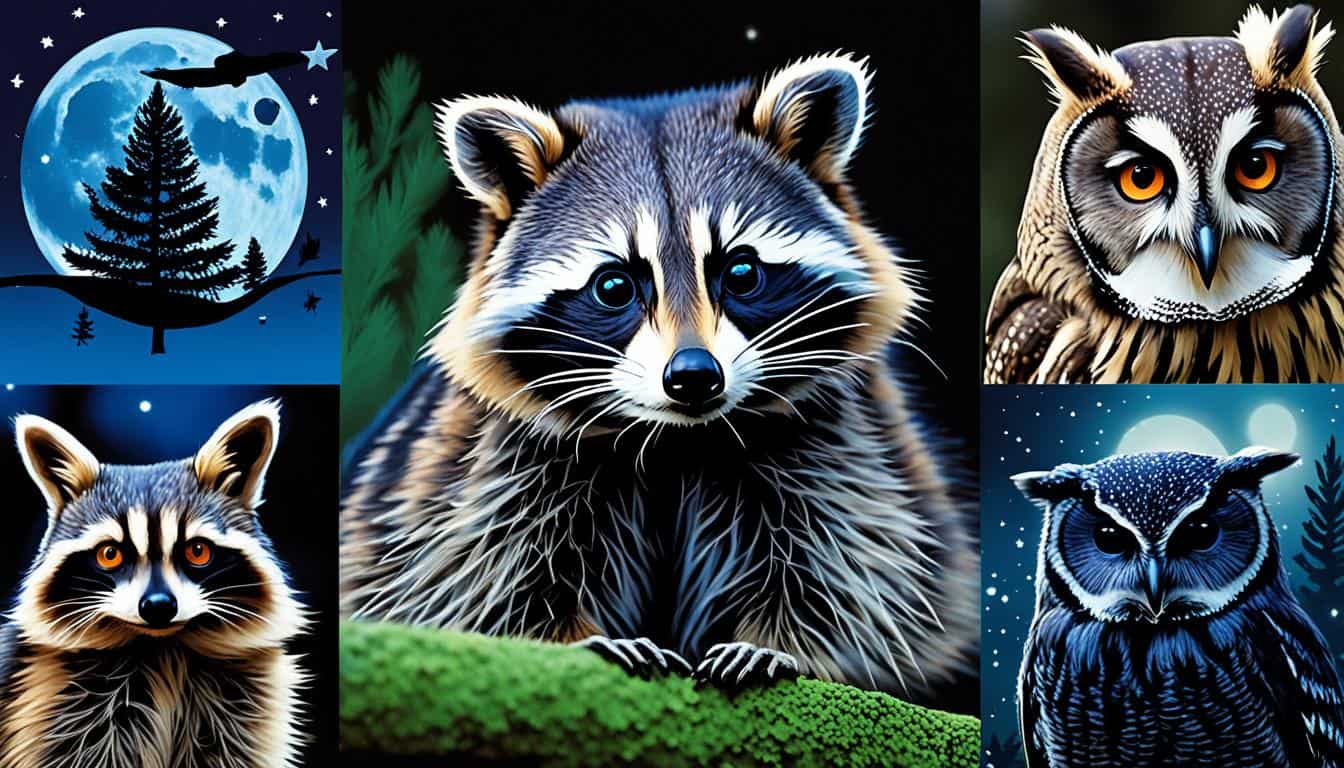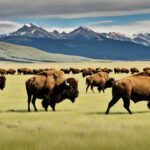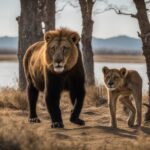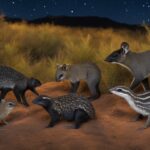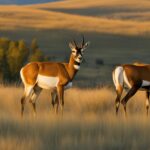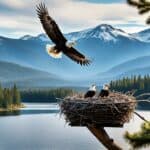After dark, North America’s wildlife shines, with various nocturnal animals coming to life. Raccoons, owls, and beavers are just a few examples. They play key roles in the ecosystem, making them interesting to study.
Raccoons are smart and often seen in cities. Owls are expert hunters in the dark, and beavers are known for their hard work. All these creatures have special skills that help them survive at night.
Introduction to Nocturnal Animals
USA nocturnal wildlife is full of interesting creatures. They are most active at night. These animals have special skills to see, hear, and smell in the dark. This helps them find food and stay safe. Their activity at night also helps keep a balance in nature.
These animals in the USA are well-adapted for the dark. They have great night vision, sharp hearing, and a strong sense of smell. This allows them to do things that animals not used to the night find hard. Studying these animals shows us how they have changed to live well at night.
Being nocturnal means these creatures do most of their activities at night. This time, however, is when many predators are inactive. It also means less competition for food. Creatures like owls and bats have really cool abilities like silent flight or finding their way with sound. These make their nighttime living possible.
Nocturnal animals in the USA do more than just survive at night. They have big roles in keeping the environment healthy. They help control pests and spread seeds. Learning about them gives us a peek into their world. It also shows us the important work they do for our ecosystems.
Raccoons: The Urban Night Dwellers
Raccoons are found all over the USA, especially at night. They search for food in city alleys and even in the wild. These animals are great at getting by in different places, making them very interesting to watch.
Diet and Behaviors
Raccoons eat just about anything, from fruits and bugs to small animals and things people throw out. They can figure out how to get food from tricky spots, showing how smart they are. One thing they do that’s very noticeable is wash their food before eating, something not many other animals do.
Habitats
Raccoons can live in many places, from the deep woods to your own backyard. They are comfortable in cities and the countryside. This shows how they can adapt to different environments and why they are so common in North America.
Bats: Midnight Insectivores
Bats are amazing animals that rule the night, keeping our ecosystems in balance. The USA is home to many bat species, making them a key part of our nighttime wildlife.
Species Diversity
The USA boasts a wide range of bats, each excelling in their own habitat. For instance, the Little Brown Bat is small and quick, while the Hoary Bat is large. They use different skills for survival, like diet, where they sleep, and how they adapt to their home.
Echolocation
Bats have a cool ability that helps them find food and navigate in the dark: echolocation. This unique sonar system lets them send out sound waves. They listen for the echoes bouncing back. This way, bats can find prey precisely and avoid danger.
Roles in Nature
Bats are super important for our planet. By eating a lot of insects, they help keep pests under control. This means we don’t need as many chemical pesticides. Certain bats are also essential for pollinating plants, especially in deserts. They pollinate at night, playing a huge role in cactus and other flower growth. Plus, bats spread seeds, which helps new plants grow, keeping our ecosystems diverse.
Their diverse roles show why it’s vital to protect bats. They’re more than just cool creatures in the dark. They help our environment, which is something we all share.
What are the most common nocturnal animals in the USA?
Many animals in the USA are active at night and are very skilled at it. For example, raccoons can be found in all sorts of places like parks and forests. They are known to look for food in the dark, which includes small animals and plants or even what people throw away.
Bats are very helpful because they eat a lot of insects. They use a special sound to find their way in the dark. This not only keeps insect numbers down but also helps plants grow by spreading their pollen.
Then there are owls, who hunt without making a sound. They can see and hear very well in the dark. This means they can catch their prey, like mice, at night.
The opossum is unique because it’s the only marsupial in North America. It eats a lot of ticks, which helps prevent the spread of Lyme disease. Also, it can get bitten by poisonous snakes and not get hurt. This makes it quite interesting.
Beavers are quite active at night. They are known for building dams and homes. These structures help keep water levels steady and create new homes for many other animals.
Here’s a quick summary of commonly found nocturnal animals in the USA:
| Animal | Key Characteristics |
|---|---|
| Raccoons | Omnivorous, urban and rural habitats |
| Bats | Insect control, echolocation |
| Owls | Silent hunters, exceptional vision |
| Opossums | Tick control, immunity to venom |
| Beavers | Engineering dams and lodges |
The USA has a lot of different nocturnal animals, from the city to the forest. Getting to know these creatures helps us see the complex balance in nature. Each of them has a role that contributes to our environment.
Owls: Silent Predators of the Night
Owls are essential night-time hunters in the USA. They are known for their silent flight and top-notch hunting skills. These birds of prey have special features that help them rule the night.
Diet and Hunting Techniques
Owls eat a variety of foods, such as small mammals, insects, and birds. They hunt with extreme precision and quietness. Their special feathers allow them to fly without making noise.
They can get close to their prey without being heard. Their excellent eyesight and hearing help them see and hear in darkness. This makes them unstoppable hunters at night.
Common Species
In the United States, many types of owls can be found. Each species has unique features. The Great Horned Owl has horn-like tufts. The Barn Owl has a heart-shaped face. Also, the tiny Eastern Screech Owl is a skilled hunter despite its size. These owls show the amazing variety among USA’s night hunters.
Adaptations
Owls have special features for living in the dark. Their eyes are designed to see well in low light. They also have ears that help them locate sounds precisely.
Owls can fly quietly because of their feather structure. This silent flight helps them sneak up on their prey. These abilities make them extremely effective night-time hunters.
Opossums: North America’s Only Marsupial
Opossums are special because they’re the only marsupials in North America. They are active at night and have unique traits that make them stand out. These include their varied diet and interesting behaviors.
Opossums can eat many things, which helps them live in different places. Their food includes insects, small animals, fruits, and veggies. They help control tick numbers by eating up to 5,000 of them in a year.
Opossums also have an amazing immune system. They are very resistant to snake venom and rabies. This keeps them safe from a lot of threats, making them strong and adaptable in their habitat.
They have a famous defense called “playing possum.” When scared, they act like a dead animal. This can scare off attackers, giving the opossum a chance to run away. It’s a clever way they protect themselves in the wild.
Because of what they eat and how they defend themselves, opossums are very important in their habitat. Learning about them helps us understand the rich world of North America’s nighttime animals.
Coyotes: Adaptable Nighttime Hunters
Coyotes are top nighttime hunters in the USA, showing amazing adaptability. They live well in different places, mastering the wild and even cities. They change their ways and what they eat depending on what’s around them and people’s actions.
Diet and Behaviors
Coyotes eat a mix of foods, from small critters and bugs to fruit and sometimes big prey. This varied diet helps them live in many places. They hunt at night, moving quietly, and sometimes working together to catch food. No wonder they’re essential in the USA’s night scene.
Interactions with Humans
Coyotes are showing up more in cities as they spread out. They’re attracted by easy meals, like food in trash or for pets. It’s important for us to learn to live with them safely. People and experts are thinking of ways for both coyotes and us to share space peacefully, with respect.
Skunks: The Nighttime Foragers
Skunks are known for a powerful smell. It’s their way of protecting themselves. They like to hunt at night and eat many things.
Diet and Foraging Behavior
Skunks eat bugs, small animals, and plants. They look for food everywhere, even near people. This wide diet means they can live in many places.
Defensive Mechanisms
Skunks have a unique way to stay safe. They spray a bad smell when they’re scared. This smell keeps most enemies away. It shows how they protect themselves and fit in different places.
Knowing about skunks helps us see their big role. They keep nature’s balance by hunting at night.
Beavers: Nighttime Engineers
Beavers are famous for reshaping the land at night. They are a key part of the USA’s nighttime wildlife. They work hard all night, changing their environment in big ways.

Building Habits
Beavers use their sharp teeth and cleverness to cut trees. They gather branches to make complex dams and lodges. These constructions slow down water, creating ponds that protect them. Their work also helps other animals by making new homes in the water.
Ecological Impact
Beavers change the land a lot through their night work. They make new wetlands that are vital for many plants and animals. Wetlands help keep the plant and animal variety strong. These wetlands also do important jobs like controlling the water level, stopping erosion, and making water cleaner. Beavers show just how crucial they are for the night life in the USA.
Conclusion
Nocturnal animals across the USA are key to a healthy environment. For example, raccoons adapt well to city life. Owls are efficient hunters, and beavers change waterways. Each of these animals is crucial to its surroundings.
Knowing about nocturnal wildlife helps us understand their impact. Raccoons, bats, and owls help by controlling pests or pollinating. They even adapt to city living. This makes nighttime creatures vital for biodiversity and our ecosystem health, both in rural and city areas.
Learning about night-time animals lets us see the beauty of American nature after dark. It shows us the need to protect their homes. The dark hours are alive with energy, proving how nature can thrive in various conditions.
FAQ
What are the most common nocturnal animals in the USA?
Raccoons, bats, owls, opossums, coyotes, skunks, and beavers are common at night in the USA. They’re important to the environment. Each has special skills to live and prosper in the dark.
What makes an animal nocturnal?
Nocturnal animals are active at night. They use better senses like smell and hearing to find food. Their night vision helps them move in the dark without being seen.
How do raccoons adapt to urban environments?
Raccoons are smart omnivores. They find food in places like trash cans and sewers. This helps them live in cities and the wild. They are known for their ability to adapt to different places.
What is echolocation, and how do bats use it?
Echolocation is like biological sonar for bats. They send out high-pitched sounds. When these sounds bounce off objects, bats know where things are. This helps them fly and find food in the dark.
Why are bats important to ecosystems?
Bats are vital for keeping the balance in nature. They eat a lot of insects, which is good for us. They also help plants grow by moving pollen and seeds around. This makes the environment healthy for everyone.
What adaptations make owls effective nocturnal hunters?
Owls are perfect for hunting at night. They see, hear, and fly silently. Their special eyes let them see well in darkness. This, along with their sound-catching ears and quiet flights, makes them great at finding prey.
What unique traits do opossums have?
Opossums are North America’s special kind of marsupial. They eat different things and are immune to some poisons. They can act like they’re dead to scare away danger. Also, they help reduce ticks by eating many of them each year.
How have coyotes adapted to urban environments?
Coyotes now come out at night in cities to stay away from people. They eat various things, including what humans throw away. They are very smart and this helps them do well in both cities and the countryside.
What are the defensive mechanisms of skunks?
Skunks protect themselves by spraying a bad-smelling liquid. This liquid can hurt the eyes and skin. Being active at night helps them stay away from danger.
How do beavers impact their environments?
Beavers build dams and lodges, which creates wetlands. These help other animals and change water flow. Their work at night has big effects on nature, making habitats for many species.

